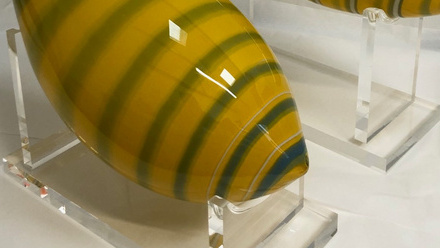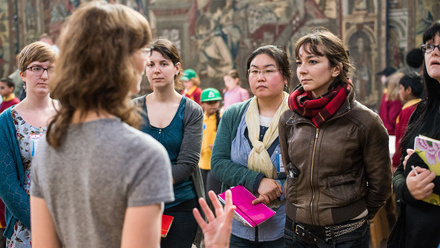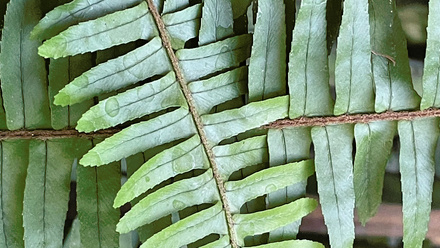The Icon Book and Paper Group Graduate Symposium is a new conference-style event which aims to highlight and celebrate the dissertations of Book and Paper Conservation professionals newly graduated from their formal education.
We hope that this event will not only demonstrate the commendable work and high level of research that students put into their dissertation projects, but like our other conferences meaningfully contribute to the existing body of knowledge in our field with insightful inquiries. The symposium will be held annually in spring and autumn, so there will be plenty of opportunities to get involved.
We are delighted to announce the following Agenda:
Leah Humenuck, West Dean College of Arts and Conservation, Rochester Institute of Technology.
The Gel, the Colour, and the Complexing Agent: An Investigation of a Rigid Gel Application of Benzotriazole for Verdigris-Damaged Paper
Abstract:
The aim of this research was an investigation into creating a rigid gel application of benzotriazole (BTA), a complexing agent, as a new potential way of treating verdigris-damaged paper. Various gel recipes were mixed and tested on historical samples. The gel recipes varied in gellan gel concentration, BTA/solvent solution concentration, and BTA concentration. The recipe effectiveness was assessed using Hulthe’s indicator paper and MQuantTM Test Cu indicator strips, two types of indicator papers which detect free copper ions. The results showed that rigid gel application of BTA is effective in complexing the copper ions which may inhibit further damage to the paper caused by free copper ions. Some of the other effects of the gel were the simultaneous removal of paper discolouration by the gel. Further research is needed to refine the gel recipes as well as the treatment process to prevent or reduce potential tidelines and other possible negative side- effects of gel treatment.
Lidija Martinović (she/her), Gallery of Matica srpska, Novi Sad, Serbia.
Conservation and restoration of chromolithography “Hercegovina′s slaves”
Abstract:
Master theses was designed as research in both artistic and scientific field of paper conservation dealing with the research of chromolithography as one of the printing techniques and conducting conservation - restoration treatment of the chromolithography "Herzegovina slaves" from the collection of the Gallery of Matica Srpska from Novi Sad (Serbia). The first part of the paper refers to the historiographical research of the occurrence and development of the technique of chromolithography, which appeared at the end of the 19th century in Western Europe. In addition to the research on historical and cultural climate which have conditioned mass production of the reproductions of oil paintings made on paper, special attention was paid to reveal the characteristics of the technique of lithography. The way the printing process has been implemented to reach a final product is important for the research of the main topic of this master theses. By answering these issues, we come to a better understanding of the very technique and its importance for our cultural heritage. The second part of the paper describes planning and implementation of conservation - restoration treatment. Selecting an appropriate way of removing surface dirt is key to the aesthetic result of the conservation, where the goal is to avoid or reduce color loss. During the cleaning, we insisted on a combination of water-based solvents in the form of buffer solutions with the addition of surfactants, as well as mechanical methods. The big challenge was the structural restoration of the losses of the paper support, which affected the stability of the work. Paper with appropriate thickness and color that best suits the original was selected for the inserts. The restoration of the painted layer (retouching) was a big challenge due to the presence of the brown overpainting at the upper right corner. This non aesthetic layer was impossible to remove during cleaning, so it was minimized with the retouching, as well as other losses of in the paint layer. The conclusion of the paper has completed the overall topic with the aim to resume the facts about the chromolithography as a historical technique and to present one typical example of its conservation and restoration, analysed from a scientific and artistic point of view.
Lauren Moon-Schott (she/her/hers), West Dean College, Boston Public Library.
A Library and Information Science Informed Conservation Paradigm
Abstract:
Conservation emerged as a distinct field during the second industrial revolution, coinciding with the formal division between libraries, archives, and museums. While the value of historic objects was already well established in the social conscious, books and other library materials were slower to be recognised for the value of their tangible nature, and largely escaped the attention of the emerging conservation field. This means that early conservation, an object-oriented profession, developed in tandem with the museum field, and became inherently linked to its values. This influence is still reflected in the objects-based ethics that have traditionally dominated the conservation mindset. Book and paper conservators, more often found in libraries and archives than museums, have long acknowledged the difference between static museum objects on display and the dynamic nature of books destined for user’s hands, but only recently has conservation literature begun to reflect a new, human-centric approach more appropriate to their needs. This thesis proposes reframing the conservation paradigm through the lens of library and information science (LIS), a field which from its foundation has centralised the needs of the institutional user rather than the perceived needs of a personified object. Within this paradigm, objects are understood as semiotic tools for the storage and transmission of information, and damage to the object as noise on an information channel. When faced with a responsibility to the user’s needs as a central mandate, conservation decision making benefits from the myriad tools developed by LIS professionals to mediate user’s information seeking behaviors, and conservators become an integral component to collections access, rather than its gatekeepers.
Bethany Procopio (she/her), Northumbria University.
Fragile layers: Consolidation of the Painted Designs in Turkey Red Pattern Books
Abstract:
This dissertation focuses on the consolidation of friable paint on paper in the context of a particular case study concerning pattern books used in the manufacture of Turkey red textiles, on loan to Northumbria University from the National Museum of Scotland. This selection of 15 unbound pages features hand-painted designs, which, due to the high pigment volume concentration (PVC) of the paint as well as the handling of the pages as practical items, have suffered damages in the form of flaking and powdering paint. The delicate nature and fragile condition of the paint as well as the complex construction of these double-sided, collaged pages presented challenging conditions for consolidation.
Research was conducted into the materiality of the paint through historical references as well as technical analysis. ATR-FTIR analysis appears to have evidenced the theory that the red paint is an alizarin lake, known in this context as Turkey red precipitate. A similar paint was reconstructed based on an historic recipe in order to create samples for comparing consolidation methods.
Based on the literature review, Funori, isinglass, gelatine, Paraloid B72, methyl cellulose and ethyl hydroxyethyl cellulose were selected and various application methods were tested, including brush application, with and without a vapour-saturated atmosphere, and the use of an ultrasonic nebuliser. Although subject to further testing, the most likely options for the consolidation of the painted designs were ethyl hydroxyethyl cellulose for local applications and Funori in an ultrasonic nebuliser for general applications.



